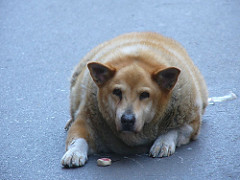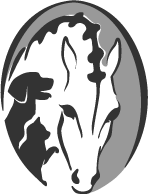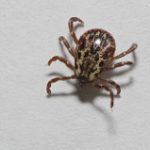Alternative Therapy for Hip Dysplasia
 Hip dysplasia is becoming an all too common problem for canines today. What was once a rarity is now a regular diagnosis, affecting an approximate 4 percent of the canine population. There are many theories as to why hip dysplasia has suddenly become popular. Some point to genetics being the only factor, others reference environment, nutrition, and activity level. The best theories are those that combine all of the above.
Hip dysplasia is becoming an all too common problem for canines today. What was once a rarity is now a regular diagnosis, affecting an approximate 4 percent of the canine population. There are many theories as to why hip dysplasia has suddenly become popular. Some point to genetics being the only factor, others reference environment, nutrition, and activity level. The best theories are those that combine all of the above.
What Hip Dysplasia Involves
First lets do a quick review of what hip dysplasia involves. The hip joint is a ball and socket joint, much like the shoulder. The pelvis acts as the socket and the femur acts as the ball. The head of the femur should fit like a glove into the acetabulum on the pelvis. There are ligaments, tendons, and cartilage present in the joint to allow it to work the way it does. In hip dysplasia, either the acetabulum is malformed or the femur head is abnormal, thus disallowing a good fit in the joint. When the fit isn’t just right, all the accessories in the joint (such as the ligaments and muscles) are stretched and pulled in all the wrong ways. The stresses on the joint become abnormal and everything must compensate for this, often resulting in laxity in the joint itself. Loose joints often lead to disrupted range of motion, spasmed muscles, a constant state of inflammation, an altered gait, sporadic limping, and pain.
 When there are problems with the hip joint one can be certain the rest of the body must begin to compensate. The knee joint and the sacroiliac joint are often the victims here, as they must make up for what the hip is lacking. Most often I have found that dogs with hip dysplasia have a tendency towards weakened knees that can lead to an increased incidence of cruciate tears. If we go upward as well these dogs may also show signs of a weakened back end sooner than most because their sacroiliac joints are not functioning as they should. All-in-all hip dysplasia is a nasty condition.
When there are problems with the hip joint one can be certain the rest of the body must begin to compensate. The knee joint and the sacroiliac joint are often the victims here, as they must make up for what the hip is lacking. Most often I have found that dogs with hip dysplasia have a tendency towards weakened knees that can lead to an increased incidence of cruciate tears. If we go upward as well these dogs may also show signs of a weakened back end sooner than most because their sacroiliac joints are not functioning as they should. All-in-all hip dysplasia is a nasty condition.
Who Are The Victims?
Some of the most prominent breeds affected include German Shepherds, Rottweilers, Dobermans, Newfoundlands, Labradors, and Golden Retrievers. What once seemed to only affect a small number has expanded due to an increase in breeding. Dogs that are overweight may also have a higher chance of showing signs of hip dysplasia. This extra weight puts more stress on the hips themselves, often accelerating the degenerative process.
 What can be done for prevention? Keeping your dog on a species appropriate diet, at a good weight, and getting regular exercise are all great ways to minimize degeneration of the hip joint. Maintaining good muscle tone and strength in the flanks will help to support the hips as well, thus limiting the stress on the joint. Proper nutrition and supplementation is imperative not only for weight purposes but also for proper growth and development. Those dogs on a proper diet and getting the correct supplements to help with joint growth and development will have a better chance of preventing hip degeneration while also protecting the joint itself.
What can be done for prevention? Keeping your dog on a species appropriate diet, at a good weight, and getting regular exercise are all great ways to minimize degeneration of the hip joint. Maintaining good muscle tone and strength in the flanks will help to support the hips as well, thus limiting the stress on the joint. Proper nutrition and supplementation is imperative not only for weight purposes but also for proper growth and development. Those dogs on a proper diet and getting the correct supplements to help with joint growth and development will have a better chance of preventing hip degeneration while also protecting the joint itself.
Altertive Treatment Options
Alternative treatments such as acupuncture, cold laser therapy, and chiropractic are all wonderful for both protective and palliative care. Regular chiropractic adjustments will help maintain proper structure in the joints surrounding the hip, while also minimizing the impact the hip itself is experiencing. Keeping these joints within normal will stabilize them and keep degeneration at a minimum. For those dogs afflicted with hip dysplasia and experiencing symptoms, it can also do wonders as far as palliative care. Restoring a joint to normalcy provides relief to the body and will decrease inflammation in the joint. In addition to these professional services, regular swimming is easy on the joints and wonderful to help maintain muscle mass and tone.

The best way to protect your pet is to be vigilant and proactive. Watch for signs of degenerative change and rather than blowing them off make note. Often times limping and pain is covered up quickly in younger dogs, but can be indicative of a much larger issue. Staying ahead of the problem is the best way to help both preventatively and palliatively.
For any questions or concerns, feel free to send us a message!
References:
- http://healthypets.mercola.com/sites/healthypets/archive/2011/11/03/prevention-of-canine-hip-dysplasia.aspx
- http://healthypets.mercola.com/sites/healthypets/archive/2010/12/09/diagnosing-and-treating-hip-dysplasia-in-pet-dogs.aspx
- http://healthypets.mercola.com/sites/healthypets/archive/2013/11/08/pet-hip-replacement-surgery.aspx
- http://www.dogsnaturallymagazine.com/dog-joint-protector/
- http://www.peteducation.com/article.cfm?c=2+2084&aid=444
Photo Credits:
Mira via photopin (license)
Murphy in the Rain via photopin (license)
Théo via photopin (license)
Buba via photopin (license)
Obese canine from New Orleans via photopin (license)




Leave a Reply
Want to join the discussion?Feel free to contribute!